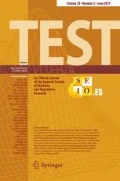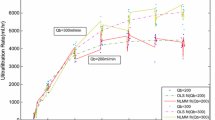Abstract
We propose a U-statistics-based test for null variance components in linear mixed models and obtain its asymptotic distribution (for increasing number of units) under mild regularity conditions that include only the existence of the second moment for the random effects and of the fourth moment for the conditional errors. We employ contiguity arguments to derive the distribution of the test under local alternatives assuming additionally the existence of the fourth moment of the random effects. Our proposal is easy to implement and may be applied to a wide class of linear mixed models. We also consider a simulation study to evaluate the behaviour of the U-test in small and moderate samples and compare its performance with that of exact F-tests and of generalized likelihood ratio tests obtained under the assumption of normality. A practical example in which the normality assumption is not reasonable is included as illustration.

Similar content being viewed by others
References
Azzalini A, Capitanio A (2003) Distributions generated by perturbation of symmetry with emphasis on a multivariate skew t-distribution. J R Stat Soc B 65:367–389
Brown KG (1976) Asymptotic behaviour of MINQUE-type estimators of variance components. Ann Stat 4:746–754
Butler SM, Louis TA (1992) Random effects models with non-parametric priors. Stat Med 11:1981–2000
Crainiceanu CM (2008) Likelihood ratio testing for zero variance components in linear mixed models. In: Dunson DB (ed) Random effect and latent variable model selection. Lecture notes in statistics, vol 192. Springer, New York, pp 3–18
Crainiceanu CM, Ruppert D (2004) Likelihood ratio tests in linear mixed models with one variance component. J R Stat Soc B 66:165–185
Demidenko E, Stukel TA (2002) Efficient estimation of the general linear mixed effects models. J Stat Plan Inference 104:197–219
Demidenko E (2004) Mixed models: theory and applications. Wiley, New York
Frees EW, Young VR, Luo Y (1999) A longitudinal data analysis interpretation of credibility models. Insur Math Econ 24:229–247
Giampaoli V, Singer JM (2009) Generalized likelihood ratio tests for variance components in linear mixed models. J Stat Plan Inference 139:1435–1448
Greven S, Crainiceanu CM, Küchenhoff H, Peters A (2008) Restricted likelihood ratio testing for zero variance components in linear mixed models. J Comput Graph Stat 17:870–891
Hachemeister CA (1975) Credibility for regression models with application to trend. In: Proceedings of the Berkeley actuarial research conference on credibility, vol 1, pp 129–163
Hájek J, S̆idák Z, Sen PK (1999) Theory of rank tests, 2nd edn. Academic Press, San Diego
Hall D, Praestgaard JT (2001) Order-restricted score tests for homogeneity in generalised linear and nonlinear mixed models. Biometrika 88:739–751
Jiang J (1998) Consistent estimators in generalized linear mixed models. J Am Stat Assoc 93:720–729
Khuri AI, Mathew T, Sinha BK (1998) Statistical tests for mixed linear models. Wiley, New York
Lencina VB, Singer JM, Stanek EJ III (2005) Much ado about nothing: the mixed models controversy revisited. Int Stat Rev 73:9–20
Lin X (1997) Variance component testing in generalised linear models with random effects. Biometrika 84:309–326
Nobre JS (2007) Tests for variance components using U-statistics. Unpublished PhD thesis, Departamento de Estatística, Universidade de São Paulo, Brazil (in Portuguese)
Nobre JS, Singer JM, Silvapulle MJ (2008) U-tests for variance components in one-way random effects models. In: Balakrishnan EN, Pena E, Silvapulle MJ (eds) Beyond parametrics in interdisciplinary research, Festschrift to P.K. Sen. IMS lecture notes-monograph series, pp 197–210
Pinheiro A, Sen PK, Pinheiro HP (2009) Decomposability of high-dimensional diversity measures: quasi U-statistics, martingales and nonstandard asymptotics. J Multivar Anal 100:1645–1656
Pinho LG, Nobre JS, Freitas SM (2012) Application of linear mixed models in actuary with influence diagnostics. Chil J Stat 3:57–73
R Development Core Team (2011) R: a language and environment for statistical computing. R Foundation for Statistical Computing, Vienna, Austria
Savalli C, Paula GA, Cysneiros FJA (2006) Assesment of variance components in elliptical linear mixed models. Stat Model 6:59–76
Self SG, Liang KY (1987) Asymptotic properties of maximum likelihood estimators and likelihood ratio tests under nonstandard conditions. J Am Stat Assoc 82:605–610
Sen PK, Singer JM, Pedroso-de-Lima AC (2010) From finite sample to asymptotic methods in statistics. Cambridge University Press, Cambridge
Sen PK, Pedroso-de-Lima AC (2011) Contiguity and irreconcilable nonstandard asymptotics of statistical tests. Braz J Probab Stat 25:444–470
Silvapulle MJ, Silvapulle P (1995) A score test against one-sided alternatives. J Am Stat Assoc 90:342–349
Silvapulle MJ, Sen PK (2005) Constrained statistical inference. Wiley, New York
Stram DO, Lee JW (1994) Variance components testing in the longitudinal mixed effects model. Biometrics 50:1171–1177
Verbeke G, Lesaffre E (1997) The effect of misspecifying the random-effects distributions in linear mixed models for longitudinal data. Comput Stat Data Anal 23:541–556
Verbeke G, Molenberghs G (2003) The use of score tests for inference on variance components. Biometrics 59:254–262
Vu HT, Zhou S (1997) Generalization of likelihood ratio tests under nonstardard conditions. Ann Stat 25:897–916
Zhang D, Lin X (2008) Variance components testing in generalized linear mixed models for longitudinal/clustered data and other related topics. In: Dunson DB (ed) Random effect and latent variable model selection. Lecture notes in statistics, vol 192. Springer, New York, pp 19–36
Zhu Z, Fung WK (2004) Variance component testing in semiparametric mixed models. J Multivar Anal 91:107–118
Acknowledgements
We are grateful to Conselho Nacional de Desenvolvimento Científico e Tecnológico and Fundação de Amparo à Pesquisa do Estado de São Paulo (FAPESP), Brazil for partial financial support. We also appreciate the enlightening comments of two anonymous referees.
Author information
Authors and Affiliations
Corresponding author
Appendix
Appendix
1.1 Proof of the contiguity result and of (12)
Denoting the densities of Y ij under \({\mathcal {H}}_{1n}\) and \({\mathcal {H}}_{0}\), respectively, by q ij and p ij we will prove the contiguity of the sequence q ij to p ij , using the LeCam’s Second Lemma (Hájek et al. 1999). For details on contiguity and Lecam’s lemmas, see Hájek et al. (1999, Chap. 7) or Sen and Pedroso-de Lima (2011), for example.
Without loss of generality, consider that e ij and b i are absolutely continuous with densities, respectively, given by

where f e and f b do not depend on unknown parameters. Under model (7), the likelihood of Y ij is

Expanding \(f_{e_{ij}}(y-\mu_{i}-b_{i})\) around b i =0, we have

where \(f_{e_{ij}}^{(1)}\) and \(f_{e_{ij}}^{(2)}\) denote the first and second derivatives of \(f_{e_{ij}}\), respectively. Substituting (31) in (30) and recalling that \(\mathbb{E} [b_{i}]=0\) and \(\operatorname{Var}[b_{i}]=\sigma_{b}^{2}\), we have

Therefore, the likelihood ratio associated to y ij is

implying that the global log-likelihood is

After some (arduous) algebra is possible to show that

where \(W_{i}=f_{e_{ij}}^{(2)}(Y_{i}-\mu_{i})/f_{e_{ij}}(Y_{i}-\mu_{i})=f_{e}^{(2)}(Y_{i}-\mu_{i})/f_{e}(Y_{i}-\mu_{i})\). Note that under \({\mathcal {H}}_{0}\), W i denote independent random variables with null means and variances σ 2, so that by the Central Limit Theorem, we have

with γ 2=δ 4 σ 2/4. On the other hand, using Khintchine´s Weak Law of Large Numbers, we conclude that

Therefore, substituting (34) and (33) in (32) and using Slutsky’s theorem, it follows that

and hence, by LeCam’s Second Lemma, contiguity holds for the considered local alternatives.
Since contiguity holds, we may appeal to LeCam’s third lemma (on the joint distribution of \(l({\bf Y})\) and J n ) under the null hypothesis and obtain the distribution of the latter under such contiguous alternatives. Incidentally, that does not need the computation of the variance of J n under contiguous alternatives. Thus, the proof of (12) follows.
1.2 Proof of (18)
First note that the ordinary least-squares estimator \(\widehat {\boldsymbol{\beta} } = ({\bf X}^{\top}{\bf X})^{-1} {\bf X}{\bf Y}\) may be re-expressed as

with

Furthermore, is possible shown that

where

with e r representing th rth element of \({\bf e}\). Is possible show that γ is a p-dimensional vector with \(\mathbb {E}[\boldsymbol{\gamma}]={\bf0}\) and \(\operatorname{Var}[\boldsymbol{\gamma}]=O(M_{n})\), since that the elements of the elements of \({{\bf x}}_{s}{{\bf x}}_{t}^{\top}\), 1≤s,t≤n are uniformly bounded by (16), implying that \(\boldsymbol{\gamma }=O_{p}(\sqrt{M_{n}})\). To proof (18), consider the following theorem on the uniform asymptotic linearity in probability of \(T_{n\widehat{\beta}}\).
Theorem 1
Under the assumptions of model (13) and conditions (16)–(17), we have

as k(n)→∞.
Proof

Recalling that \(\boldsymbol{\gamma}=O_{p}(\sqrt{M_{n}})\), then

□
Therefore, using the above result and Slutsky’s theorem it follows that (18) holds.
1.3 Proof of (19)
Under \({\mathcal {H}}_{1n}:\sigma_{b}^{2}=\delta^{2}/\sqrt{n}\), it follows that \(T_{n\widehat{\beta}}=\sum_{1 \leq r < s \leq n}\eta_{nrs} (Y_{r}-{{\bf x}}_{r}^{\top}\widehat{\boldsymbol{\beta}})(Y_{s}-{{\bf x}}_{s}^{\top }\widehat{\boldsymbol{\beta}})\) can be rewritten as

where

Now note that under \({\mathcal {H}}_{0}: \sigma_{b}^{2}=0\), \(T_{n\widehat{\beta }}= T_{n\widehat{\beta}}^{0}\) almost surely. Let u(s) denote a function that associates the subject’s index to the sth observation lexicographically ordered. The statistic A n1 can be decomposed as

implying that \(\mathbb{E}[A_{n1}]=0\). Similarly, we may be show that \(\mathbb{E}[A_{n2}]=0\). Since  , it follows that \(\mathbb{E}[A_{n3}]=\frac{\delta^{2}}{2\sqrt{n}}(n^{2}-\sum_{i=1}^{k}n_{i}^{2})\). Recalling that \(J_{n\widehat{\beta}}=T_{n\widehat{\beta}}/(S_{n}\sqrt {M_{n}})\), then by (39) we have
, it follows that \(\mathbb{E}[A_{n3}]=\frac{\delta^{2}}{2\sqrt{n}}(n^{2}-\sum_{i=1}^{k}n_{i}^{2})\). Recalling that \(J_{n\widehat{\beta}}=T_{n\widehat{\beta}}/(S_{n}\sqrt {M_{n}})\), then by (39) we have

where \(J_{n\widehat{\beta}}^{0}=T_{n\widehat{\beta}}^{0}/(S_{n}\sqrt{M_{n}})\) and \(A_{ni}^{*}=A_{ni}/(S_{n}\sqrt{M_{n}})\) (i=1,2,3). We see that \(J_{n\widehat{\beta}}^{0}\) has mean and variance asymptotic, given, respectively by 0 and 1.
Now, let

and note that \({{\bf T}}_{n1}^{*}=\sum_{1 \leq r < s \leq n}\eta_{nrs}b_{u(r)}{{\bf x}}_{s}\) is a p-dimensional vector with mean vector and covariance matrix, given, respectively, by

Considering (16), we may show that \({{\bf T}}_{n1}^{*}/\sqrt {M_{n}}=o_{p}(1)\), since that \(\varSigma_{{{\bf T}}_{n1}^{*}}=o(M_{n})\). Similarly, is possible show also that
implying that

has mean and variance asymptotic equal to zero. Along the same lines, we may show that \(A_{n2}^{*}\) also has mean and variance asymptotic equal to zero. Denoting lim n→∞ M n /n 3=λ, we have

Since b 1,…,b k are iid random variables and the n i are bounded, using \(\mathbb{E}[b_{1}^{4}]<\infty\), we have \(\operatorname{Var}[A^{*}_{n3}] \rightarrow0\). Then, by the contiguity of the sequence of local alternative hypotheses \({\mathcal {H}}_{1n}:\sigma_{b}^{2}=\delta^{2}/\sqrt{n}\), and recalling that \(S_{n}{\stackrel{{\mathbb{P}}}{\longrightarrow}}\sigma_{e}^{2}\), we have, under \({\mathcal {H}}_{1n}\),

implying that under \({\mathcal {H}}_{1n}:\sigma_{b}^{2}=\delta^{2}/\sqrt{n}\) the center of the normal distribution is shifted to the right by \(\delta^{2} / (2\sigma_{e}^{2}\sqrt{\lambda})\).
The proof of (27) follows similarly and for this reason its is omitted.
Rights and permissions
About this article
Cite this article
Nobre, J.S., Singer, J.M. & Sen, P.K. U-tests for variance components in linear mixed models. TEST 22, 580–605 (2013). https://doi.org/10.1007/s11749-013-0316-8
Received:
Accepted:
Published:
Issue Date:
DOI: https://doi.org/10.1007/s11749-013-0316-8



